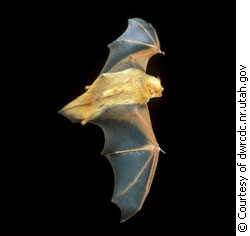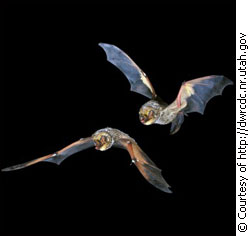
|
|
The promise of wind energy In Canada, wind farms generate enough electricity to power 440,000 homes, and the country possesses the resources to generate 40 times as much.
“Wind energy is expected to grow over 700 percent over the next decade,” says Robert Hornung, president of the Canadian Wind Energy Association. But with advances in technology and rapid industry growth, not to mention the rapid growth of the turbine structures themselves, new problems are arising that scientists admit they know very little about. Bats losing their senses In 2003, it became clear to both the scientific community and to the wind energy industry that wind turbines are a problem for bats – large numbers of them were being killed in wind turbine collisions. Unlike birds who frequently remove themselves from the gene pool by running into windows, buildings and other man made structures, bats avoid similar collisions by use of their echolocation systems, says Robert Barclay, ecologist and conservation biologist at University of Calgary. Last summer at Summerview Wind Farm in Pincher Creek, Alta, 620 dead bats, compared to only 30 birds, were found at the site, says Barclay. At several wind farms in the United States it’s estimated 1000 bats per year are killed from turbine blades. Barclay says this recent phenomena raises many questions about bats and brings to light the fact that these flying mammals have been very poorly researched in the past. “We know less than we don’t know,” he laughs. Barclay is the leading researcher in Canada on bat wind-turbine interactions. About a year ago, he began researching bat fatalities at the Summerview Wind Farm hoping to answer questions about bat behaviour that are crucial to understanding their fatal encounters with the turbines. Unanswered questions Not all species of bats are falling victim to the giant pinwheels, and not all wind farms are equally implicated in taking the creatures lives. Across North America, the same three species – red bat, silver haired bat, and hoary bat – are showing up dead on wind farms, and all three species are migratory bats, says Barclay.
“We also know not all wind farms are equally a problem,” he says. Analysis of the recent data collected on bat mortality rates at wind farms show that wind farms with taller turbines are sites of higher bat mortality. “Maybe the blades are up higher and into the air space in which bats migrate,” says Barclay. “The problem is we know almost nothing about migratory patterns of these mammals…we don’t know what height they migrate at, we don’t know their migratory paths. We need to learn them and build our wind farms accordingly.” Although bat fatalities could clearly be avoided if wind farms were absent along the bats’ migratory pathways (if studies reveal there are indeed migratory pathways), it is still unknown why the bats are colliding with the turbines when their echolocation should allow them to navigate around the massive structures.
A multitude of hypotheses are being considered, says Barclay. “[The bats] may be attracted to the motion or movement of the blades, they may see the structures as a possible roosting site, or it’s possible the blades are moving so fast the bats don’t have time to react,” he says. Even though the cause of the collisions is still only speculative, the wind energy industry and conservationists alike are eager to find a solution. Jamming the system Ed Arnett, conservation scientist for Bat Conservation International in Texas, is heading a research initiative to determine if an acoustic device that “jams” the bats echolocation will deter the animals from areas of danger. Bats use echolocation to paint an auditory picture of their surroundings. A bat emits a high frequency ultrasound through its mouth and listens for an echo bouncing off an object. The bat’s brain processes the difference between the sound it emits and the sound it hears back and uses this information to navigate through its environment and locate prey.
The idea behind the acoustic deterring device is for the wind turbines to emit a high frequency sound that can interfere with the bat’s own ultrasound signals. The hope is this will disrupt the bat’s navigation abilities and the bat will avoid the area altogether, says Arnett. “That’s the theory, but whether you can jam it and deter them that effectively, that’s the next question.” He says often deterring wildlife does not work as planned because animals either habituate to the deterrent or simply don’t respond as expected. However, in laboratory tests on a colony of captive brown bats, the device showed promise. In a number of trials, researchers at the University of Maryland who are partnered with Bat Conservation International, observed the flight patterns of the bats and whether or not they were altered by the acoustic deterrent device. The bats were released into a “sound” room that had been divided into quadrants. In each trial the deterrent device was randomly placed in one of the quadrants and the bats behaviour was recorded. The results of the trials showed the bats were much less likely to fly into or land in the quadrant of the room with the device when it was emitting sound.
These test results indicate the device does influence bat behaviour, which was enough to take the testing to the next level outside the laboratory, says Arnett. In field tests, Arnett observed bat behaviour at various ponds in Eastern Oregon where bats were known to forage. For two nights he studied their behaviour with the deterrent device turned off and on the third night he switched the device on. This field study found bat activity in the area was reduced by about 50 percent when the acoustic deterrent device was turned on. “Our goal for these field tests was simply to make a decision as to whether we were having an affect on behaviour,” says Arnett. “We feel this gave us enough evidence to move forward with the next generation of deterrent devices.” Good for business Arnett says the wind energy industry has been very cooperative and supportive of his research. “From a business perspective, it is easier to come up with a solution like this one than not to site wind farms altogether or to turn the turbines off during periods of high fatality,” he says, but he warns it may not be the most effective solution. Ultrasound dissipates very quickly in the air, he says. Once a frequency is found that is an effective deterrent, the problem will be projecting the sound out far enough from the turbine for the bat to hear in time to avoid it. “You would need a pretty powerful unit to project the ultrasound to have an effective range on the bats before they get into harms way,” says Arnett. “It may require an array of speakers around each turbine to form an ultrasound fence, which may ultimately be more expensive than other options.”
|
|
|


